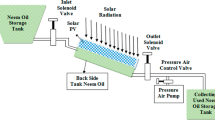Abstract
Refrigeration, Ventilation and Air Conditioning system is the largest reason behind the increasing demand of energy consumption in the world and saving that energy through some innovative methods becomes a large issue for the researchers. Compressor is a primary component of the refrigeration cycle. The application of nanoparticles in refrigeration cycle overcomes the energy consumption issue by improving the compressor suction and discharge characteristics. In this paper, an experimental study is carried out to investigate the effect of copper oxide (CuO) nanoparticles on different parameters of the refrigeration cycle. CuO particles are appended with the system refrigerant through lubricating oil of the compressor. Further, the viscosity measurements and friction coefficient analysis of compressor lubricant for different fractions of nanoparticles has been investigated. The results showed that both the suction and discharge characteristics of the compressor were enhanced with the utilization of nanolubricant in LPG based refrigeration cycle. Nanoparticles additive in lubricant increases the viscosity which lead to a significant decrease in friction coefficient. The COP of the cycle was improved by 46%, as the energy consumption of the compressor was decreased by 7%.










Similar content being viewed by others
Abbreviations
- m:
-
Mass of water (kg)
- δt:
-
Temperature difference
- t:
-
Time (sec)
- Cp :
-
Specific heat kJ kg−1 K−1
- K:
-
Energy meter constant.
- n:
-
Number of pulses taken in energy meter
- HTC:
-
Heat transfer coefficient
- MO:
-
Mineral oil
- CuO:
-
copper oxide
- COP:
-
Coefficient of performance
References
Elcock D (2007) Potential impacts of nanotechnology on energy transmission applications and need. ANL/EVS/TM/08-3, Argonne National Laboratory (ANL)
Wang RX, Hao B, Xie GZ, Li HQ (2003) A refrigerating system using R134a and mineral oil appended with n-TiO2 (R) as working fluids. Proceedings of the 4th international symposium on HAVC, Tsinghua University Press, Beijing, China, pp 888-892
Jiang W, Peng H, Jing D, Yu H, Gao Y (2009) Heat transfer characteristics of refrigerant based nanofluid flow boiling inside a horizontal smooth tube. Int J Refrig 32(6):1259–1270
Tazarv S, Saffar-Avval M, Khalvati F, Mirzaee E, Mansoori Z (2016) Experimental investigation of saturated flow boiling heat transfer to TiO2/R141b nanorefrigerant. Exp Heat Transfer 29(2):188–204
Wang KJ, Ding GI, Jiang WT (2006) Nanoscale thermal transporting and its use in engineering. Proceedings of the 4th symposium on refrigeration and air condition. Southest University Press, Nanjing, China, pp 66-75
Wu X-M, Peng LI, Hui LI, Wang W-C (2008) Investigation of pool boiling heat transfer of R11 with TiO2 nanoparticles. J Eng Thermophys 28:124–126
Park KJ, Jung D (2007) Boiling heat transfer with CNTs for refrigerants used in building air conditioning. Energy Build 39(9):1061–1064
Zhang SY, Ge Z, Wang HT, Wang H (2016) Characteristics of flow boiling heat transfer and pressure drop of MWCNT–R123 Nanorefrigerant: experimental investigations and correlations. Nanoscale Microscale Thermophys Eng 20(2):97–120
Peng H, Ding G, Jiang W, Gao Y (2009) The migration charateristics of nanoparticles in the pool boiling process of nanorefigerant and nanorefrigerant oil mixture. Int J Refrig 32(1):114–123
Ding G, Jiang W, Peng H (2009) Measurements and model of thermal conductivities of carbon nanotubes nanorefrigerant. Int J Therm Sci 48(6):1108–1115
Jwo CS, Jeng LY, Teng TP, Chang H (2009) Effects of nanolubricant on performance of hydrocarbon refrigerant system. J Vac Sci Technol 27(3):1473–1477
Lee K, Hwang Y, Cheong S, Kwon L, Kim S, Lee J (2009) Performance evaluation of nanolubricants of fullerene nanoparticles in refrigeration mineral oil. Curr Appl Phys 9(2):128–131
Abbas M, Walvekar R, Hajibeigy M, Javadi F (2013) Efficient air—condition unit by using nano—refrigerant. In 1st Engineering undergraduate research catalyst conference, Selangor Darul, Malaysia, 1-2 July 2013
Hussen H (2016) Experimental investigation for titanium oxide nanoparticles as a lubricant additive for a compressor of window type air conditioner system. Journal of. Engineering 20(2):62–72
Kumar R, Singh J (2016) Effect of ZnO nanoparticles in R290/R600a based vapour compression refrigeration system added via lubricant oil on compressor suction and discharge charateristics. Heat Mass Transf. https://doi.org/10.1007/s00231-016-1921-3
Krishna Sabareesh R, Gobinath N, Sajith V, Das S, Sobhan CB (2012) Application of TiO2 nanoparticles as a lubricant additive for vapour compression refrigeration system- an experimental investigation. Int J Refrig 35:1989–1996
Xing M, Wang R, Yu J (2014) Application of fullerene C60 nano oil for performance enhancement of domestic refrigerator compressors. Int J Refrig 35:398–403
Author information
Authors and Affiliations
Corresponding author
Ethics declarations
Conflict of interest
The research paper has no conflict of interest.
Rights and permissions
About this article
Cite this article
Kumar, R., Singh, J. & Kundal, P. Effect of CuO nanolubricant on compressor characteristics and performance of LPG based refrigeration cycle: experimental investigation. Heat Mass Transfer 54, 1405–1413 (2018). https://doi.org/10.1007/s00231-017-2231-0
Received:
Accepted:
Published:
Issue Date:
DOI: https://doi.org/10.1007/s00231-017-2231-0




